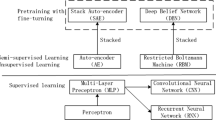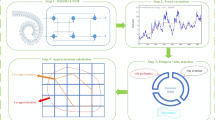Abstract
In this paper, considering the effect of multiple delayed states on the reservoir itself, based on the advantage of the empirical wavelet transform, an improved ESN with multiple delayed states is proposed, called multi-state delayed echo state network with empirical wavelet transform (EWT-MSD-ESN). Firstly, the empirical wavelet transform is used to decompose the input signal, and then the main features of all decomposed components of the input signal can be extracted. Secondly, considering the multi-state delayed capability of the reservoir, the reservoir state equation of the EWT-MSD-ESN can be adjusted adaptively by using the autocorrelation coefficient of the input signal, such that the intrinsic characteristics of different learning tasks can be fully reflected. Finally, four numerical simulation examples and two actual examples are used to validate the predictive performance of EWT-MSD-ESN.





















Similar content being viewed by others
References
Jaeger H (2001) The ‘echo state’ approach to analysing and training recurrent neural networks-with an erratum note. German National Research Center for Information Technology, GMD Report 148
Li X, Bi FR, Zhang LP, Lin JW, Bi XB, Yang X (2022) Rotating machinery faults detection method based on deep echo state network. Appl Soft Comput 127:109335
Kleyko D, Frady EP, Kheffache M, Osipov E (2022) Integer echo state networks: efficient reservoir computing for digital hardware. IEEE Trans Neural Netw Learn Syst 33(4):1688–1701
Wang ZJ, Zhao H, Zheng MW, Niu SJ, Gao XZ, Li LX (2023) A novel time series prediction method based on pooling compressedsensing echo state network and its application in stock market. Neural Netw 164:216–227
Yao XS, Wang ZS, Huang ZJ (2021) A stability criterion for discrete-time fractional-order echo state network and its application. Soft Comput 25:4823–4831
Zhang GG, Zhang C, Zhang WD (2020) Evolutionary echo state network for long-term time series prediction: on the edge of chaos. Appl Intell 50:893–904
Najibi E, Rostami H (2015) SCESN, SPESN, SWESN: three recurrent neural echo state networks with clustered reservoirs for prediction of nonlinear and chaotic time series. Appl Intell 43:460–472
Zhang HY, Hu B, Wang XY, Xu JP, Wang L, Sun Q et al (2021) Self-organizing deep belief modular echo state network for time series prediction. Knowl-Based Syst 222:107007
Yao XS, Wang ZS (2019) Broad echo state network for multivariate time series prediction. J Frank Inst 356(9):4888–4906
Yao XS, Shao YN, Fan SY, Cao SX (2022) Echo state network with multiple delayed outputs for multiple delayed time series prediction. J Frank Inst 359(18):11089–11107
Liao YB, Li HM (2019) Deep echo state network with reservoirs of multiple activation functions for time-series prediction. Sādhanā: Acad Proc Eng Sci 44:1–12
Gao RB, Du L, Duru O, Yuen KF (2021) Time series forecasting based on echo state network and empirical wavelet transformation. Appl Soft Comput 102:107111
Zhang H, Zheng MW, Zhang YP, Yu X, Li WC, Gao H (2021) Application of ESN prediction model based on compressed sensing in stock market. Commun Nonlinear Sci Numer Simul 101:105857
Liu ZY, Li SX, Pan MY, Loo CK (2022) Grammatical structure detection by instinct plasticity based echo state networks with genetic algorithm. Neurocomputing 467:173–183
Wang HS, Wu QMJ, Wang DS, Xin JB, Yang YM, Yu KJ (2021) Echo state network with a global reversible autoencoder for time series classification. Inf Sci 570:744–768
Li N, Tuo JY, Wang YQ, Wang MH (2020) Prediction of blood glucose concentration for type 1 diabetes based on echo state networks embedded with incremental learning. Neurocomputing 378:248–259
Gao RB, Li RL, Hu MH, Suganthan PN, Yuen KF (2023) Dynamic ensemble deep echo state network for significant wave height forecasting. Appl Energy 329:120261
Li FJ, Li Y (2023) Robust echo state network with cauchy loss function and hybrid regularization for noisy time series prediction. Appl Soft Comput 146:110640
Wang ZJ, Zhao H, Zheng MW, Niu SJ, Gao XZ, Li LX (2023) A novel time series prediction method based on pooling compressed sensing echo state network and its application in stock market. Neural Netw 164:216–227
Basterrech S, Rubino G (2023) Evolutionary Echo State Network: A neuroevolutionary framework for time series prediction. Appl Soft Comput 144:110463
Wang L, Su Z, Qiao JF, Deng F (2022) A pseudo-inverse decomposition-based self-organizing modular echo state network for time series prediction. Appl Soft Comput 116:108317
Guo X, Li WJ, Qiao JF (2023) A self-organizing modular neural network based on empirical mode decomposition with sliding window for time series prediction. Appl Soft Comput 145:110559
Nguyen HP, Baraldi P, Zio E (2021) Ensemble empirical mode decomposition and long short-term memory neural network for multi-step predictions of time series signals in nuclear power plants. Appl Energy 283:116346
Abdallah M, Mohammadi B, Nasiri H, Katipoǧlu OM, Abdalla MAA, Ebadzadeh MM (2023) Daily global solar radiation time series prediction using variational mode decomposition combined with multi-functional recurrent fuzzy neural network and quantile regression forests algorithm. Energy Rep 10:4198–4217
Iwabuchi K, Kato K, Watari D, Taniguchi I, Catthoor F, Shirazi E et al (2022) Flexible electricity price forecasting by switching mother wavelets based on wavelet transform and long short-term memory. Energy and AI 10:100192
Anggraeni W, Yuniarno EM, Rachmadi RF, Sumpeno S, Pujiadi P, Sugiyanto S et al (2024) A hybrid EMD-GRNN-PSO in intermittent time-series data for dengue fever forecasting. Expert Syst Appl 237:121438
Zhu Q, Zhang F, Liu S, Wu YQ, Wang L (2019) A hybrid VMD-BiGRU model for rubber futures time series forecasting. Appl Soft Comput 84:105739
Abebe SA, Qin TL, Zhang X, Yan DH (2022) Wavelet transform-based trend analysis of streamflow and precipitation in upper blue nile river basin. J Hydrol Reg Stud 44:101251
Feng ZK, Niu WJ, Tang ZY, Jiang ZQ, Xu Y, Liu Y et al (2020) Monthly runoff time series prediction by variational mode decomposition and support vector machine based on quantum-behaved particle swarm optimization. J Hydrol 583:124627
Liang HT, Gao J, Qiang N (2021) A novel framework based on wavelet transform and principal component for face recognition under varying illumination. Appl Intell 51:1762–1783
Dong HB, Han S, Pang JW, Yu XD (2023) A joint network of non-linear graph attention and temporal attraction force for geo-sensory time series prediction. Appl Intell 53:17346–17362
Gilles J (2013) Empirical wavelet transform. IEEE Trans Signal Process 61(16):3999–4010
Huang NE, Shen Z, Long SR, Qu MC, Snin HH, Zheng Q et al (1998) The empirical mode decomposition and the hilbert spectrum for nonlinear and non-stationary time series analysis. R Soc 454:903–995
Olkkone JT (2011) Discrete wavelet transforms: theory and applications. BoD-Books on Demand
Dragomiretskiy K, Zosso D (2014) Variational mode decomposition. IEEE Trans Signal Process 62(3)
Jaeger H, Lukoševičius M, Popovici D, Siewert U (2007) Optimization and applications of echo state networks with leaky-integrator neurons. Neural Netwo 20(3):335–352
Lun SX, Yao XS, Hu HF (2016) A new echo state network with variable memory length. Inf Sci 370:103–119
Bo YC, Wang P, Zhang X (2020) An asynchronously deep reservoir computing for predicting chaotic time series. Appl Soft Comput 95:106530
Acknowledgements
This work is supported in part by the National Natural Science Foundation of China under Grant 62203103 and Grant 62003274, and in part by the Jilin Provincial Department of Education Scientific Research Project under Grant JJKH20240152KJ.
Author information
Authors and Affiliations
Corresponding author
Additional information
Publisher's Note
Springer Nature remains neutral with regard to jurisdictional claims in published maps and institutional affiliations.
Rights and permissions
Springer Nature or its licensor (e.g. a society or other partner) holds exclusive rights to this article under a publishing agreement with the author(s) or other rightsholder(s); author self-archiving of the accepted manuscript version of this article is solely governed by the terms of such publishing agreement and applicable law.
About this article
Cite this article
Yao, X., Wang, H., Shao, Y. et al. Multi-state delayed echo state network with empirical wavelet transform for time series prediction. Appl Intell 54, 4646–4667 (2024). https://doi.org/10.1007/s10489-024-05386-1
Accepted:
Published:
Issue Date:
DOI: https://doi.org/10.1007/s10489-024-05386-1




